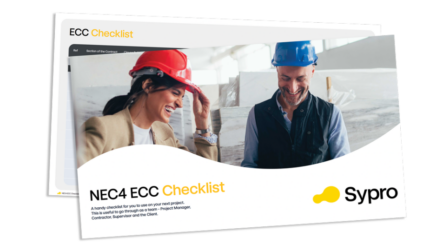
In our latest webinar, Dr Stuart Kings, technical director at Sypro and co-author of NEC3/4 Practical Solutions, walks us through the NEC4 Engineering and Construction Contract (ECC) secondary Options. He explains what each clause means and how to apply them correctly.
What are secondary Options?
Under the NEC, secondary Options provide flexibility in NEC4 contracts, allowing parties to tailor the agreement to suit specific project needs. While not all secondary Options are commonly used, some are essential. Their absence can increase contractor risk and discourage bids.
These clauses can be grouped into four main categories:
- Commercial
- Legal
- Insurance
- Climate change
If you’re preparing an ECC, an essential guidance resource is Volume 2, which includes detailed examples on how to complete contract data and select the right secondary Options.
When it comes to day-to-day contract management, contract management systems like Sypro digitise your NEC contract. They allow you to track progress, stay compliant with alerts and monitor early warnings in real time, helping you avoid disputes and make informed decisions confidently.
Let’s explore some of Dr Stuart Kings’ insights into these often-misunderstood secondary Options.
Detailed overview of NEC4 secondary Options
X1 Price adjustment for inflation
Commercial
Risk to the Client
Used with Options A, B, C, and D.
This clause allows contract prices to adjust in line with inflation indices. It protects both parties from unpredictable cost increases and is often used in long-term contracts or in sectors with volatile material prices such as energy or infrastructure.
X2 Changes in the law
Legal
Risk to the Client
X2 allows for compensation events if a change in law affects the Contractor’s work, time or cost. It provides a fair mechanism to adjust the contract, reducing the need for Contractors to price for unknown legal risks.
This is an all-or-nothing clause and is strongly recommended, especially for contracts that run over five to ten years. Although legal changes usually take time, even short-term contracts benefit from including it.
X3 Multiple currencies
Commercial
Risk to the Client
Used with Options A and B
X3 enables payments in more than one currency, which is ideal for international projects or when sourcing from global suppliers. It adds flexibility to support cross-border operations.
X4 Ultimate Holding Company Guarantee
Legal
Risk to the Contractor
Often used on high-value public sector projects
Previously known as the Parent Company Guarantee, this clause requires the Contractor’s parent company to guarantee contract performance. It gives the Client added assurance but must be supported by legal advice, as NEC doesn’t provide a drafted version. The guarantee should be provided within four weeks of the contract date to avoid potential breach notices or termination.
X5 Sectional completion
Commercial
Risk to the Contractor
Time related
X5 enables different parts of a project to be completed and handed over at various stages, each with its own completion date and potential delay damages. It suits phased developments such as schools or hospitals and is often paired with X6 to incentivise early handovers.
X6 Bonus for early completion
Commercial
Risk to the Client
Time related
Popular in the private sector, this clause rewards early completion. The bonus is agreed in advance and paid daily, acting as a performance incentive that can align commercial drivers on time-sensitive projects. It is commonly used where early delivery creates significant value for the Client.
X7 Delay damages
Commercial
Risk to the Contractor
Time related
The counterpart to X6, this clause sets out daily financial penalties for project delays, including weekends and bank holidays.
X8 Undertakings to the Client and Others
Commercial
Legal
Risk to the Contractor
Introduced in NEC4 to address a common Z clause, this Option is still rarely used in practice. It applies when the Contractor is required to provide warranties from sub-contractors to the Client, guaranteeing their work in the event the Contractor becomes insolvent. This typically involves the Contractor giving undertakings to third parties. As with similar clauses, the NEC does not draft these warranties, so additional legal support will be required.
X9 Transfer of Rights
Commercial
Legal
Risk to the Contractor
X9 allows the client to use or reproduce the contractor’s documents and designs on other projects. It clarifies intellectual property rights and is particularly useful for clients like hotel chains replicating designs across multiple locations.
X10 Information modelling
Commercial
Legal
Risk to the Contractor
Something that is becoming increasingly more natural in the supply chain, X10 encourages the use of digital models (e.g. BIM) within the contract, setting out what data must be delivered and in what format. Particularly useful for large or complex projects, it helps coordinate digital collaboration and communication across project teams.
X11 – Termination by the Client
Commercial
Legal
Risk to the Contractor
X11 is crucial for contracts as it provides the Client with the right to terminate the contract under specific circumstances, including for convenience. It ensures that the contract includes clear rules on how termination payments are calculated and what happens to the works and responsibilities upon termination. This offers flexibility for the Client while ensuring the Contractor is fairly compensated for work done.
X12 – Multiparty Collaboration
Commercial
Not to be used with X20.
Previously known as ‘partnering’ in NEC3, X12 supports collaboration between the Client and multiple suppliers under shared performance incentives. It’s designed to align behaviours through mutual benefits, rather than traditional contract boundaries. It can reduce conflict and improve delivery outcomes but requires cultural buy-in and detailed planning. It’s rarely used in practice but can be powerful in integrated team settings.
X13 – Performance Bond
Commercial
Legal
Risk to the Contractor
Not be used with X4
X13 provides the Client with a performance bond – a third-party guarantee, normally issued by a bank or insurance company – that compensates the Client if the Contractor defaults. It provides a financial safeguard for the client to ensure Contractor obligations are met. If a Contractor was to go under, the Client would be covered for the cost of finding a new one and any compensation. The bond value and terms are agreed upon contractually.
X14 – Advance Payment
Commercial
Legal
Risk to the Client
Supporting cash flow, particularly in third-party funded projects, X14 enables the Client to make advance payments, typically to help with mobilisation or upfront procurement. It’s often used on large or capital-intensive projects and requires a bond in place within four weeks to protect the Client.
X15 – Contractor’s Design
Commercial
Legal
Risk to the Client
Common in the UK, this secondary Option is another one that should definitely be in your contracts. It establishes responsibility for design liability and ensures Contractors are only required to exercise reasonable skill and care and not to guarantee a design is fit for purpose.
X16 – Retention
Commercial
Risk to the Contractor
Not to be used with Option F
X16 enables the Client to hold back a percentage of payments until the work is completed to the required standard. This encourages the Contractor to rectify defects promptly and fully complete works. Another Option that is either in or out; retention is gradually released, often in stages.
X17 – Low Performance Damages
Commercial
X17 allows the Client to apply financial penalties if the Contractor fails to meet specified performance levels during or after completion, for example, if a building doesn’t meet agreed energy efficiency or operational standards. These damages are separate from delay damages (X7) and must relate to clearly defined performance criteria in the Scope.
X18 – Limitation of Liability
Legal
Commercial
Risk to the Client and Contractor
This clause caps the Contractor’s total financial liability under the contract. It may also exclude or limit specific types of damages, like indirect losses. No matter how many claims are made, the total liability for all of them will be limited to the amount stated to avoid excessive risk exposure. If X18 is not included in the contract, a Contractor has unlimited liability, therefore it’s crucial for Contractors to include this.
X20 – Key Performance Indicators (KPIs)
Legal
Commercial
Risk to the Client and Contractor
This clause supports the Client to set KPIs often linked to bonuses or penalties, however it can’t be used in conjunction with X12. It encourages continuous improvement and accountability, allowing measurable performance targets such as community engagement or fewer complaints.
X21 – Whole Life Cost
Climate change
Commercial
Risk to the Client
Rarely used in practice, X21 encourages the Contractor to suggest design or construction changes that reduce long-term operation or maintenance costs. Proposals are evaluated based on life-cycle value, not just initial cost. If accepted, the Contractor may share in the savings or receive other benefits. This aligns with sustainability goals and better long-term asset performance.
X22 – Early Contractor Involvement
Commercial
Risk to the Client
Used with Option C and E
A recommended approach aligned with The Construction Playbook, this Option encourages early engagement of contractor expertise to ensure that what is being procured is achievable throughout the whole process. It allows the Contractor to advise on buildability, programme, and cost risks before work begins.
X29 – Climate Change
Risk to the Contractor
Another Option that is relatively new and incredibly underused is X29. Introduced in 2022, this clause integrates climate-related obligations into the contract. It allows the Client to set emissions targets, materials requirements or reporting duties. Contractors must comply and may be incentivised for exceeding goals or penalised for underperformance. It supports net-zero strategies and positions sustainability as a contractual, not just voluntary, goal.

Dr Stuart Kings’ recommendations
While secondary Options in NEC4 are technically optional, some are widely recommended to help manage risk and avoid disputes. They are:
- X2 – Changes in the Law
- X11 – Termination by the Client
- X15 – Contractor’s Design
- X18 – Limitation of Liability
Best practice tips
Avoid overlapping clauses like X4 and X13, or X12 and X20, which can create confusion. Clearly list all chosen secondary Options upfront to set expectations.
Use ‘what-if’ scenarios to guide your clause selection, thinking about likely risks and key trade-offs like cost vs. time. For extra clarity, follow the Volume 2 guidance on filling out contract data correctly. It’s one of the easiest ways to avoid conflict later on.
How Sypro can help
Sypro’s NEC contract management software is designed to make clause management and risk allocation straightforward. It helps you apply the right secondary Options consistently across your project, ensures contract data is completed accurately and supports compliance with NEC processes every step of the way.
With real-time tracking, automated workflows and built-in prompts for key actions, Sypro reduces the risk of missed deadlines or contractual oversights – keeping your project on time, on budget and fully aligned with NEC best practice.
Watch the latest webinar here or contact us for more information on how Sypro can help our contract management.
Book a free demonstration








